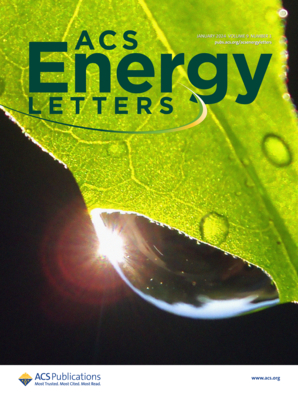Temperature-Adaptive Fluorine in Electrolyte for Lithium–Metal Batteries at Low Temperatures
IF 18.2
1区 材料科学
Q1 CHEMISTRY, PHYSICAL
引用次数: 0
Abstract
Li-metal batteries (LMBs) are heavily constrained at low temperatures due to increased ion desolvation and transportation barriers. Here, we report a weakly solvating sulfonamide-based electrolyte that features a temperature-sensitive local chemical environment of the fluorine atoms in the sulfonamide molecules at low temperatures. The reactivity of the sulfonamide with Li-metal is further tailored by the adaptive fluorine chemistry at low temperatures, promoting the formation of more conductive LiFx components in the solid-electrolyte interphase. Benefiting from these characteristics, our electrolyte enables high Li-metal reversibility and delivers a high discharge capacity of 164.4 mAh g–1 at −30 °C (197.9 mAh g–1 at 25 °C) with a high capacity retention of 83.0% after 180 cycles at −30 °C in a 4.6-V-class Li||NMC622 battery, significantly outperforming the carbonate-based electrolyte. These results highlight the critical role of electrolyte design in practical LMBs under extreme conditions.低温下锂金属电池电解液中的温度自适应氟
由于离子溶解和运输障碍的增加,锂金属电池(lmb)在低温下受到严重限制。在这里,我们报道了一种弱溶剂化的磺胺基电解质,其特点是在低温下磺胺分子中的氟原子具有温度敏感的局部化学环境。在低温下,自适应氟化学进一步调整了磺胺与锂金属的反应性,促进了固体-电解质界面中更导电的LiFx组分的形成。得益于这些特性,我们的电解质具有高的锂金属可逆性,并在- 30°C时提供164.4 mAh g-1的高放电容量(25°C时为197.9 mAh g-1),在- 30°C的4.6 v级Li||NMC622电池中进行180次循环后的高容量保持率为83.0%,显着优于碳酸盐基电解质。这些结果突出了电解质设计在极端条件下实际lmb中的关键作用。
本文章由计算机程序翻译,如有差异,请以英文原文为准。
求助全文
约1分钟内获得全文
求助全文
来源期刊

ACS Energy Letters
Energy-Renewable Energy, Sustainability and the Environment
CiteScore
31.20
自引率
5.00%
发文量
469
审稿时长
1 months
期刊介绍:
ACS Energy Letters is a monthly journal that publishes papers reporting new scientific advances in energy research. The journal focuses on topics that are of interest to scientists working in the fundamental and applied sciences. Rapid publication is a central criterion for acceptance, and the journal is known for its quick publication times, with an average of 4-6 weeks from submission to web publication in As Soon As Publishable format.
ACS Energy Letters is ranked as the number one journal in the Web of Science Electrochemistry category. It also ranks within the top 10 journals for Physical Chemistry, Energy & Fuels, and Nanoscience & Nanotechnology.
The journal offers several types of articles, including Letters, Energy Express, Perspectives, Reviews, Editorials, Viewpoints and Energy Focus. Additionally, authors have the option to submit videos that summarize or support the information presented in a Perspective or Review article, which can be highlighted on the journal's website. ACS Energy Letters is abstracted and indexed in Chemical Abstracts Service/SciFinder, EBSCO-summon, PubMed, Web of Science, Scopus and Portico.
 求助内容:
求助内容: 应助结果提醒方式:
应助结果提醒方式:


